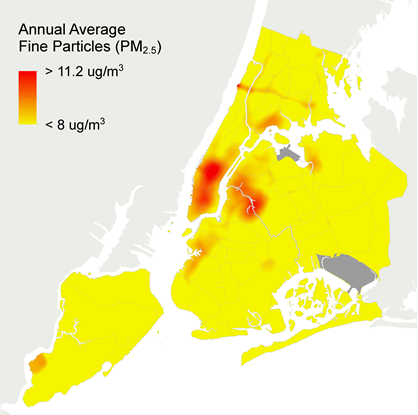Health Department Releases Report on Improvements in Citywide Air Quality
The report covers eleven years of data from the largest urban air monitoring program of any U.S. city
Average levels of fine particulate matter, nitrogen dioxide and sulfur dioxide declined between 2009 and 2019
April 22, 2021 — The Health Department today released the latest New York City Community Air Survey (NYCCAS) report, which describes continuing improvements in air quality citywide and is available in an interactive online format. The report summarizes eleven years of data of the largest ongoing urban air monitoring program of any U.S. city. It describes seasonal trends in air pollution levels from winter 2008-2009 through fall 2019 and highlights sources that contribute to high levels of pollutants in New York City neighborhoods. Maps displaying neighborhood air pollution levels by year are also included online.
“Air quality has tangible health impacts and we’re pleased to see air quality in NYC improving year after year,” said Health Commissioner Dr. Dave A Chokshi. “Mayor de Blasio’s OneNYC plan continues to bring us closer to the goal of making sure all New Yorkers can breathe clean air.”
“Working collaboratively with all stakeholders New York City has developed progressive clean air policies that have resulted in increasingly healthier air for all New Yorkers,” said DEP Commissioner Vincent Sapienza. “Thank you to our partners at the Department of Health for all of their important work on the Community Air Survey.”
NYC Community Air Survey Findings Between 2009 and 2019
- Annual average levels of fine particulate matter (PM 2.5), nitrogen dioxide and nitric oxide have declined 38%, 33% and 52%, respectively.
- The largest declines have been observed for sulfur dioxide, due largely to city and state heating oil regulations – wintertime average levels have declined by 97%.
- Summertime average ozone levels have remained stable.
High levels of fine particulate matter, nitrogen dioxide, and nitric oxide – pollutants that exacerbate heart and respiratory disease – continue to be observed in areas of high traffic density, building density, and industrial areas. PM2.5 emissions from buildings have continued to decline, reflecting the impact of city regulations of heating oil. For the first time emissions from commercial cooking - grills and charbroilers in restaurants – best explain the differences in fine particulate concentrations among neighborhoods. Recent City Air Code updates have created a framework to collaboratively start addressing these emissions sources. A closer look at commercial cooking emissions and NYCCAS is available in Tracking changes in New York City’s sources of air pollution
More data on local air quality and other health issues related to the environment can be found at the New York City Environment and Health Data Portal
About the New York City Community Air Survey (NYCCAS) and OneNYC
The Health Department conducts NYCCAS with Queens College of the City University of New York to evaluate how air quality differs across New York City. Air pollution measurements are taken each season with monitors mounted at street level at about 100 locations throughout the five boroughs. More information on NYCCAS can be found here.
The de Blasio administration, through the Health Department’s NYCCAS and its OneNYC plan, is prioritizing the reduction of emissions and air quality improvement citywide.
About OneNYC: New York City’s Green New Deal
OneNYC 2050 is a strategy to prepare New York City for the future. The OneNYC 2050 strategy reflects the core strengths of New York City — a growing, diverse population, a strong economy, and global leadership — as well as our significant challenges: rising unaffordability, economic insecurity, stubborn health and wealth inequities, and the existential threats posed by climate change, decaying infrastructure, and rising global intolerance. OneNYC 2050 outlines bold actions New York City will take to overcome these challenges and create a strong and fair future for all New Yorkers, including efforts to mitigate the impacts of climate change and improve air quality in neighborhoods throughout New York City.
###
#013-21
MEDIA CONTACT: Patrick Gallahue / Michael Lanza,
pressoffice@health.nyc.gov






